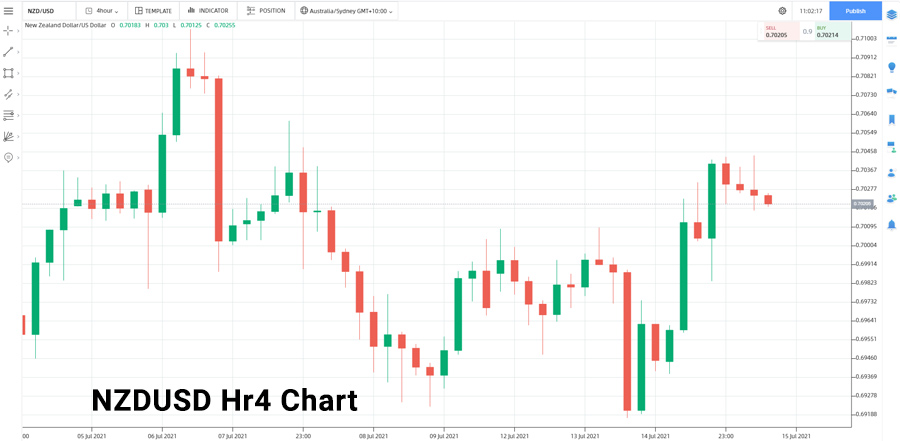Kiwi Soars, RBNZ Nods Rate Rise; Dollar Slides, Fed Sticks to Script

- Michael Moran , Senior Currency Strategist at ACY Securities
- 15.07.2021 11:00 am trading
US Treasury Yields Retreat; Loonie Flat After BOC Stands Pat
Summary: The Kiwi, a flightless bird endemic to New Zealand, and also the name given to its currency by FX traders, sprouted wings and soared 1.3% to 0.7035 (0.6943). New Zealand’s central bank, the RBNZ chose to end its Quantitative Easing program by July 23 and signalled a shift toward a rate rise. On the other side of the Pacific, US Federal Reserve Chair Jerome Powell stressed that monetary policy would continue to offer “powerful support” to the economy “until the recovery is complete.” The Dollar Index (USD/DXY), a favoured gauge of the Greenback’s value against a basket of 6 major currencies, slid 0.42% to 92.35 from 92.77 yesterday. The Bank of Canada kept its key overnight interest rate unchanged at 0.25% and reduced the target of weekly bond purchases. The move was widely expected, and the USD/CAD pair ended little changed at 1.2505 (1.2515). The Australian Dollar climbed to 0.7480 from 0.7445 even as Sydney’s Covid-19 lockdown was extended for another two weeks. Australia’s most populous city recorded 97 new Covid-19 infections. Sterling rallied to 1.3861 from 1.3815 on the broadly based weaker Greenback as well as a stronger UK CPI report. The US Dollar slumped 0.57% against the Japanese Yen to 109.97 (110.62) as US Treasury bond yields retreated. The benchmark US 10-year rate slid to 1.35% from 1.42% yesterday.
The EUR/USD pair reversed its fall, climbing 0.52% to 1.1837 in late New York from its 1.1780 close yesterday. Against the Asian and Emerging Market currencies, the US Dollar was mostly lower. USD/CNH (Dollar- Offshore Chinese Yuan) dipped 0.33% to 6.4580 (6.4800) while USD/SGD eased to 1.3530 (1.3560). Wall Street stocks edged higher as bond yields retreated. The DOW was last at 34,950 (34,907) while the S&P 500 settled at 4,377 (4,370).
Other global bond yields were mostly flat. Japan’s 10-year JGB yield was unchanged at 0.01%. UK Ten-Year Gilt yields settled at 0.63% (0.63%) Germany’s 10-year Bund rate was at -0.32% (-0.30%).
Data released yesterday saw Australia’s Westpac Consumer Confidence Index rise to 1.5% from a previous -5.2%. Japan’s May Industrial Production (m/m) eased to -6.5% against forecasts of -5.9%.
UK June CPI (y/y) rose to 2.5% from 2.1% in May, beating estimates at 2.2%. Britain’s June Producer Price Index Input (m/m) slid to -0.1% against estimates of 1.2%, while PPI Output (m/m) fell to 0.4% from 0.5%, lower than expectations of 0.6%. Eurozone May Industrial Production (m/m) fell -1.0% from +0.8% in April, missing estimates at 0.6%. US June Headline Producer Price Index (m/m) rose to 1% from 0.8%, and higher than forecasts of 0.5%. US June Core PPI (m/m) rose to 1% from 0.7% and above estimates of 0.5%.
- NZD/USD – soared 1.3% to 0.7035 from yesterday’s open at 0.6943 to finish as best performing Major. The Kiwi had a choppy session slipping to an overnight low at 0.6939 just ahead of the RBNZ’s rate decision and announcement. The hawkish bent from the RBNZ, though not totally unexpected, surprised markets by its language, and suggested timing.
- USD/JPY – The Dollar’s 0.57% slide against the Yen put the Japanese currency as second best performing Major. The retreat in the benchmark US 10-year bond yield by 7 basis points (1.35%) weighed heavily on the USD/JPY pair. Jerome Powell testified to the US Congress that the Fed was still “a ways off” from levels it wanted to see before any tapering of monetary policy support.
- GBP/USD – Sterling turned around and reversed its losses to finish at 1.3860, up 0.40% (1.3815). While UK CPI beat forecast, Producer Prices were mixed. It was the broad-based USD weakness that really lifted the British currency.
- AUD/USD – The Aussie Battler took its support from its smaller cousin the Kiwi this time. The Aussie finished at 0.7480 from its 0.7445 open yesterday. Broad-based US Dollar weakness also supported the Australian Dollar. The current rise in Covid-19 cases in New South Wales saw its lockdown extended for two weeks. Which will weigh on the economy.
On the Lookout: Markets turn their focus to today’s economic data releases. Australia kicks off with its June Employment report. Australia’s economy is expected to have added 19,700 jobs in June from 115,200 in May. The Unemployment Rate is forecast unchanged at 5.1%. China also reports on its June Retail Sales (y/y f/c at 10.9% from 12.4%), June Industrial Production (y/y f/c 7.8% from 8.8%), Fixed Asset Investment (y/y f/c 12.1% from 15.4%), Unemployment Rate (f/c 5.0% from 5.0%). European data start with Germany’s June Wholesale Prices (m/m f/c 1.5% from 1.7%. y/y f/c 10.7% from 9.7% - ACY FInlogix). The UK reports on its May Average Earnings (previous was 5.6%, no forecasts), May Unemployment Rate (f/c 4.7% from 4.7%), June Claimant Count Change, ie Unemployment Claims (f/c -32,500 from previous -92,600). Canada kicks off North American reports with its June ADP Employment Change (previous was 101,600, no forecasts). The US releases its Philadelphia Fed Manufacturing Index for July (f/c 29.8 from 30.7), New York Empire State Manufacturing Index (f/c 18.0 from 17.4), Weekly Unemployment Claims (f/c 350,000 from 373,000), June Industrial Production (m/m f/c 0.8% from 0.8%), June Manufacturing Production (m/m previous was 0.9%, no forecasts), and finally US June Capacity Utilisation Rate (f/c 75.6% from 75.2%).
Trading Perspective: After the Fed’s Jerome Powell spelled out that the US central bank is in no hurry to change its easy monetary policy “until the recovery is complete”, the Dollar lost ground. Meantime the Kiwi outperformed as the RBNZ chose to end its QE program and shifted to a hawkish stance. While the Bank of Canada reduced the target of its weekly bond purchases, the move was widely expected. Other global central banks have reiterated that there will not be any interest rate moves until 2023. This may start to change as more economic data are released.
Meantime markets are also focussed on the recent rise in the Delta variant of Covid-19 infections amidst a mixed vaccine roll-out. This will provide haven support for the Greenback. We can expect further choppy trading in the days ahead given these occurrences.
- NZD/USD – Best performing Major, the Kiwi continues to grind higher in early Asia. The Flightless Bird found its wings and is cruising, currently at 0.7038. Overnight high traded was 0.7044 which is likely to give way at some stage today. Immediate resistance lies at 0.7070 followed by 0.7100. Immediate support can be found at 0.7000 and 0.6970. Look for further choppy trade in the Kiwi between 0.6970-0.7070. Good money to be made trading the range.

(Source: Finlogix.com)
- USD/JPY – remains the most sensitive currency pair to moves in the benchmark US 10-year treasury bond yield. The Greenback slid to an overnight low at 109.95 before settling at 109.97. This morning the low traded was 109.93. Immediate support can be found at 109.70 followed by 109.40. Immediate resistance can be found at 110.30 followed by 110.70. The US bond yields will continue to drive this currency pair.
- AUD/USD – The Aussie slide was reversed by the overall weaker US Dollar and the strong performance of its smaller cousin, the Kiwi. AUD/USD hit an overnight low at 0.7431 before reversing higher to trade at 0.7486, overnight peak. The Aussie Battler settled at 0.7480 at the New York close, not far off its highs. Immediate resistance lies at 0.7500 followed by 0.7530. Immediate support can be found at 0.7450 and 0.7420. Australia releases its Employment report today and any surprises will make for choppy trade. Happy days!
- USD/CAD – Against the Loonie, the Greenback closed little changed at 1.2505 (1.2515). While overall USD weakness provided support for the Canadian Loonie, the Bank of Canada’s decision following its policy meeting was widely expected. USD/CAD traded to an overnight low at 1.2424 after the BOC reduced the target of its weekly net asset purchases (to CAD 2 billion from CAD 3 billion). This was less than expected. Canada’s central bank adopted a cautious tone in its statement which did not help the Loonie. BOC Governor Tiff Macklem is due to deliver his remarks on policy in a press conference shortly. Watch out, we have some fireworks here. Immediate resistance lies at 1.2530 (overnight high 1.2526) followed by 1.2560. Immediate support can be found at 1.2470 and 1.2440. Look for further choppy
- trade in a likely 1.2430-1.2530 range today/ Prefer to sell into USD strength.
While the currencies stayed within recent ranges, trading was choppy with some good movement. For the US Dollar it was a case of “what goes up, must come down, spinning wheel got to go round” as the Blood Sweat and Tears sang in their 1969 hit. The wheel may go back up again, have fun spinning it round. Happy trading and top Thursday all.
























